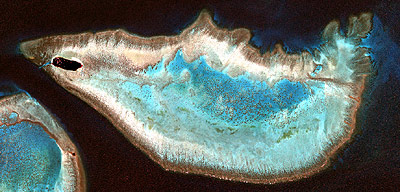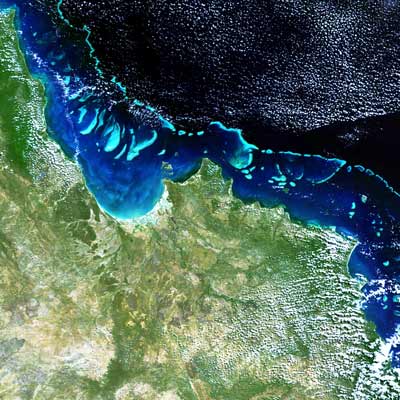Satellite monitors health of coral reefs
European Space Agency news release
October 5, 2005

This high-resolution IKONOS satellite image of the Heron Island reef was used for validation of the analysis. Photo courtesy of CSIRO.
Australian researchers have found Envisat’s MERIS sensor can detect coral bleaching down to ten metres deep. This means Envisat could potentially monitor impacted coral reefs worldwide on a twice-weekly basis.
Coral bleaching happens when symbiotic algae living in symbiosis with living coral polyps (and providing them their distinctive colours) are expelled. The whitening coral may die with subsequent impacts on the reef ecosystem, and thus fisheries, regional tourism and coastal protection. Coral bleaching is linked to sea temperatures above normal summer maxima and to solar radiation. Bleaching may take place on localised and mass scales there was an extensive bleaching event in 1998 and 2002 likely linked to El Niño events.
“An increase in frequency of coral bleaching may be one of the first tangible environmental effects of global warming,” states Dr. Arnold Dekker of Australia’s Commonwealth Scientific and Industrial Research Organisation’s (CSIRO) Wealth from Oceans Flagship program.”The concern is that coral reefs might pass a critical bleaching threshold beyond which they are unable to regenerate.”
Aerial or boat-based observation is the current method of detecting bleaching, but many reefs are either inaccessible or simply too large (the Great Barrier Reef has an area of 350 000 square kilometres) for an event that happens within a fortnight. Bleached corals may rapidly be colonised by blue-green to brown algae, more difficult to distinguish from live coral.
 An Envisat MERIS image of the Great Barrier Reef off Australia’s Queensland coast, centred on Cape York Peninsula. Taken on 19 August 2004, this MERIS Full Resolution mode images has a spatial resolution of 300 metres. Photo courtesy of ESA. |
Repetitive, objective and broad-scale satellite coverage is the alternative. At this week’s MERIS/AATSR Workshop in Frascati, Italy, the CSIRO team presented initial results using Envisat’s Medium Resolution Imaging Spectrometer (MERIS). MERIS acquires images in 15 different spectral bands at 300 m resolution.
“Coral bleaching needs to be mapped at the global scale,” Dekker adds. “High-spatial resolution satellites can only do it on a few reefs due to cost and coverage constraints. We need a system that has appropriate coverage and revisit frequency, with a sufficient amount of spectral bands and sensitivity. There is no more suitable system than MERIS.”
The team studied Heron Island reef at the southern end of the Great Barrier Reef, site of a University of Queensland research station. Validating MERIS Full Resolution mode results, they found that observed changes in live coral cover were correlated to an existing bleaching event.
Theoretical studies indicate that for each complete 300-metre pixel of coral under one metre of water it is possible to detect a 2% bleaching of live coral. MERIS should remain sensitive to detecting from 7-8% bleached coral even under ten metres of water.
 This February 2004 MERIS Full Resolution image shows the southern end of the Great Barrier Reef, with a close-up of the Heron Island reef, used as a test area for coral bleaching detection during the one-year programme, funded by the Wealth from Oceans Flagship and the CSIRO Earth Observation Centre. Photo courtesy of ESA/CSIRO. |
“MERIS Full Resolution covers the world every three days, a bottleneck for global monitoring could be data processing,” Dekker concludes. “However satellite sensors measuring sea surface temperature such as Envisat’s Advanced Along Track Scanning Radiometer (AATSR) can be applied to prioritise reefs that are subject to sea temperature heating anomalies-thus focusing the MERIS based bleaching detection.
Australia’s Great Barrier Reef Marine Park Authority has expressed interest in the project. Australian scientists plan to progress to perform MERIS monitoring of bleaching events up to the scale of the whole Great Barrier Reef.
Related articles:
European Space Agency analyzes Hurricane Rita September 23, 2005
As Hurricane Rita entered the Gulf of Mexico, ESA’s Envisat satellite’s radar was able to pierce through swirling clouds to directly show how the storm churns the sea surface. This image has then been used to derive Rita’s wind field speeds.
Divers to monitor health of coral reefs in the UAE September 12, 2005
According to an article in Gulf News, The Emirates Diving Association is training its members and staff to monitor the health of the coral reefs and marine life in the UAE.
Dubai’s artificial islands have high environmental cost August 23, 2005
While there have been numerous articles written recently about the proliferation of artificial island projects, the astounding “The World” venture among them, few have addressed or assessed the environmental impact of such massive undertakings and the transformation of both the sea and landscape. Until recently, Nakheel, the government-controlled corporation developing these ambitious projects, has been able to focus predominantly on promoting rather than defending the islands, but new evidence of environmental detriment is bringing the company and its projects under fire from certain groups.
Reefs worth more for tourism than fishing in Australia May 8, 2005
The planet’s largest living organism is worth more to Australia as an intact ecosystem than an extracative reserve for fishing. Stetching more than 2,300km along the northeast coast of Australia, lies the world’s largest reef and the only living structure visible from the moon. The Great Barrier Reef, made up of about 2,900 unconnected coral reefs and roughly 900 islands, is home to over 1,500 species of fish and 400 species of coral making it one of the most important marine ecoystems on Earth.
This is a modified news release from the European Space Agency. The original version appears at Health of coral reefs detected from orbit